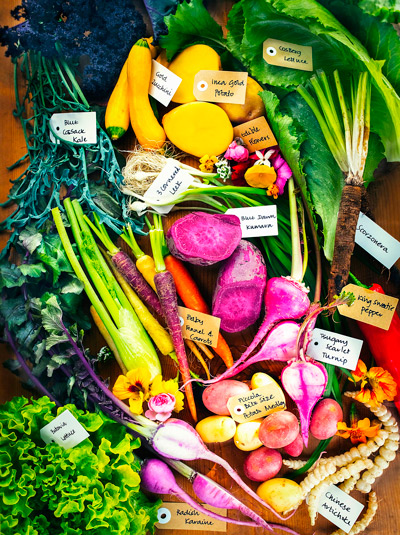
Shoppers are embracing packaged veges that save time in the kitchen – but trendy new varieties are also tempting our taste buds.
It would almost have been laughable 10 years ago to see peeled and chopped veges on the shelves, ready for a stir fry or roasting. But these days, well-packaged prepared mixed vegetables fly out the supermarket doors as time-poor shoppers embrace shortcuts. These ready-to-cook vegetables sit alongside bags of pre-washed salads and leafy greens (please rewash them!) and veges aimed at kids – such as baby carrots and tomatoes specially grown in small sizes and colourfully packaged.
But what is in the future for vegetables? Every food trend starts with a daring or innovative chef who spots something new and exciting and works it onto the menu. Often, chefs will approach growers with requests, and once the food industry spots these new ideas, it’s not long before the new vegetables become mainstream fare.
Here are some of the latest varieties of vegetables that have found their way onto supermarket shelves, along with a few new types driven by top chefs and boutique growers.
Inca Gold potatoes: This new variety, originating from the phureja cultivar found in the Andean valleys of South America, is a golden moist potato that bakes and roasts nicely. It has a sweet buttery flavour and is widely available in supermarkets in 1kg packs. Cooking idea: Roll the peeled potatoes in a light olive oil, sprinkle with salt, pepper and chopped thyme and bake at 190°C for one hour. No need to add butter or sour cream as they have a lovely buttery texture.
Purple Dawn kumara: Also known as Blue Dawn, this kumara joins the traditional red, orange and yellow varieties grown primarily in the Kaipara District alongside the Northern Wairoa River. This variety was developed by Plant & Food Research, has a firm texture and is a little less sweet than traditional kumara. Cooking idea: Make a colourful purple kumara salad. Peel or scrub the kumara, steam until tender, then toss with chopped spring onion, fresh New Zealand orange segments, rocket leaves and finely chopped basil in a vinaigrette made with orange juice, mustard and olive oil.
King Sweetie peppers: These long peppers are surprisingly sweet, with thinner skins than the red capsicums we’re used to. Part of the Sweet Palermo family, they also have fewer seeds, making them excellent for salads. Cooking idea: Cut the peppers into strips and toss in a frying pan with crushed garlic and olive oil, stirring often so the peppers don’t burn. When soft, serve with sliced basil, pepper and salt. Lovely with steak.
Piccolo bite-sized potato medley: For many years, the only tiny potatoes we saw were new-season jersey bennes, but now, year round, a variety of very small gold, red and purple potatoes are packaged together in convenient 700g packs. Cooking idea: Wash the potatoes well and steam until tender. Toss in butter and paprika with chopped parsley to serve or use them whole in your favourite potato salad recipe.
Batavia lettuce: This crunchy lettuce is one of the unsung heroes of the salad world. The top-selling lettuce in France, it has flavour, it retains its crunch and every leaf from the outside to the middle can be used. Two varieties are commercially grown, one a darker green with a slightly larger head. Serving idea: Wash the leaves and line a platter when making a large potato, pasta or rice salad.
Cosberg lettuce: This hardy lettuce is a result of crossing cos lettuce with iceberg. The large, wide leaves are crunchy and tasty, perfect for salads and also for adding at the last minute when stir-frying a vegetable mix. Cooking idea: Make a spicy Asian mince pork mixture (larb) and use the cosberg lettuce to roll the meat mixture in for a refreshing family meal.
Baby fennel and carrots: For a long time, baby versions of carrots, beetroot, turnips, fennel and more were the domain of the chef, but now they’re in many supermarkets. They are tender, sweet and cook quickly. Cooking idea: Melt a little butter with some olive oil in a heavy pan. Toss in a selection of washed and trimmed baby vegetables, reduce the heat, cover the pan and cook very slowly until all are soft. To serve, sprinkle with some finely chopped soft leafy herbs.
Gold zucchini: A new colourful variety of the traditional zucchini, picked when small so they are sweet and fresh. Cooking idea: Cut each zucchini in half lengthwise. Toss in olive oil, a sprinkling of ground cumin, salt and freshly ground pepper and grill on a ridged pan for 5-6 minutes. Delicious to accompany beef or lamb leg steaks.
Edible flowers: Using flowers for decoration has become a trend. Their colour and delicacy lightens up the plate. Some markets will stock small packs of flowers, with nasturtiums, herbs, pansies and marigolds popular. Any herb in the garden that’s flowering can be used as a garnish, but take care to never use inedible or poisonous flowers. Avoid lilies, oleanders and hydrangeas. Serving ideas: Take care not to overdo edible flowers. Judicious use recommended.
Radish Karaine: There are many variants on the traditional red radish, with its white interior. Look for the blush-pink variety, pictured on the previous page, or a stunning watermelon radish with a red interior and white rim. Serving idea: Slice very thinly and add to salads for colour and texture.
Tsugaru Scarlet turnip: This tastes like a traditional turnip but adds a splash of colour and interest to the plate. Cooking idea: Add whole or halved to casseroles and braises for extra flavour.
Blue Cossack kale: This fine-leafed spidery kale is a new variety. Cooking idea: Blanch for 2-3 minutes and use as an unusual garnish for serving with meaty dishes or deep fry quickly to add interest to complex vegetarian dishes.
Purple curly kale: A very coarse leafy kale to be used in the same manner as most kale. Cook for at least 10 minutes to soften.
These last three vegetables are only in development stage and are at present offered to only a handful of restaurants.
Three-Cornered Leeks: These leeks need little cooking and can be used as a garnish for meat or fish.
Scorzonera: This hardy root vegetable has a taste reminiscent of an oyster. Boil the roots, scoop out the white interior and eat with a little butter and salt.
Chinese artichokes: Also called crosnes, these cute vegetables look like a caterpillar. They are a tuber and can be braised, roasted or added for a tasty note to soups and casseroles.
Thanks to The Secret Garden, Eighty4 tomatoes and vegetables.co.nz.
This article was first published in the July 8, 2017 issue of the New Zealand Listener.










